Abstract
1. The fraction of red in a red--green mixture matched to yellow increased as the intensities of the match constituents were increased sufficiently to bleach appreciable chlorolabe and erythrolabe. 2. All changes in matching found for a given normal trichromat, (i) with increase in the intensities of the matching components, (ii) as a function of time after the onset of very intense components, (iii) with change in the pupil region through which light enters the eye, and (iv) with change in the region of the retina under test, are consistent with the assumption that matching depends upon the absorption of light in three kinds of (individually colour blind) cones, each with its own visual pigment, provided that the lambda max densities of the latter can vary in the range 0.25--1.0 (common logarithmic units) depending upon the subject. 3. Individual differences in matching among normal (as well as among both varieties of red--green anomalous) trichromats, on the other hand, suggest that the extinction spectra of the cone pigments sensitive to long and medium wave lengths may differ from one trichromat to the next.
Full text
PDF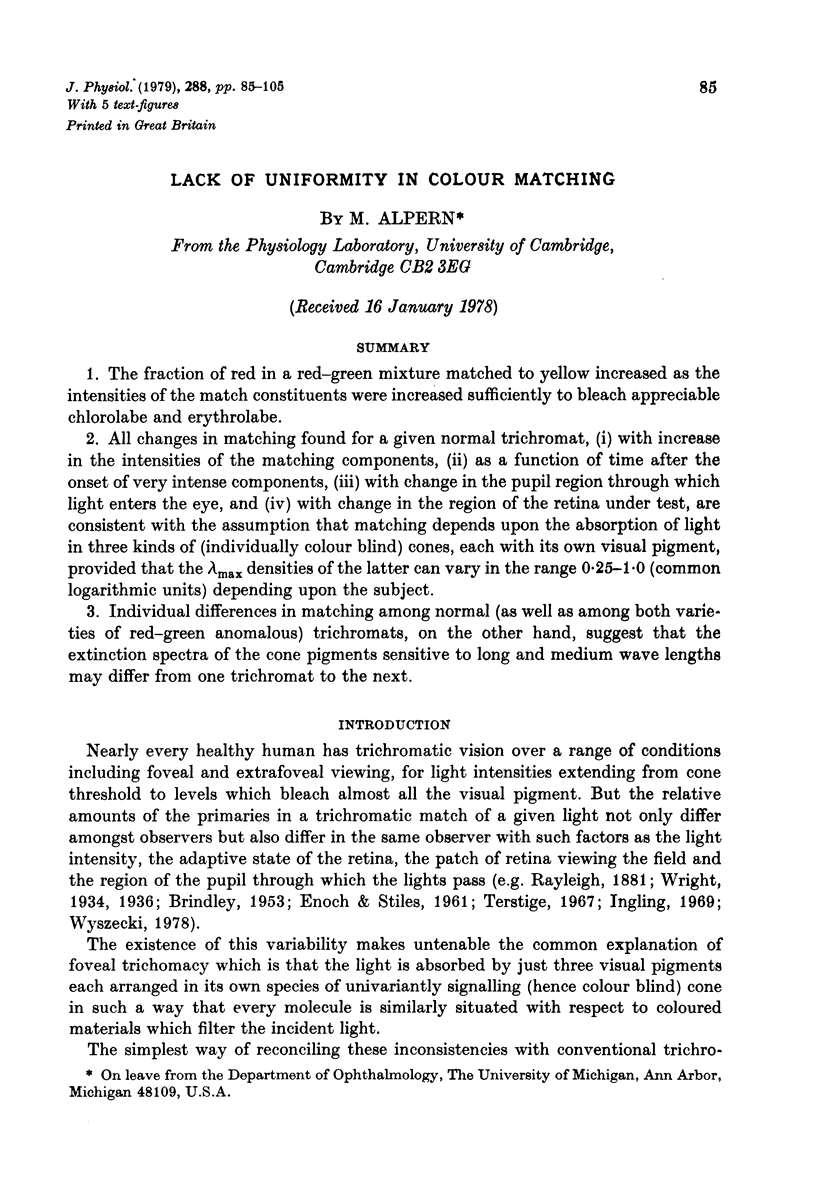
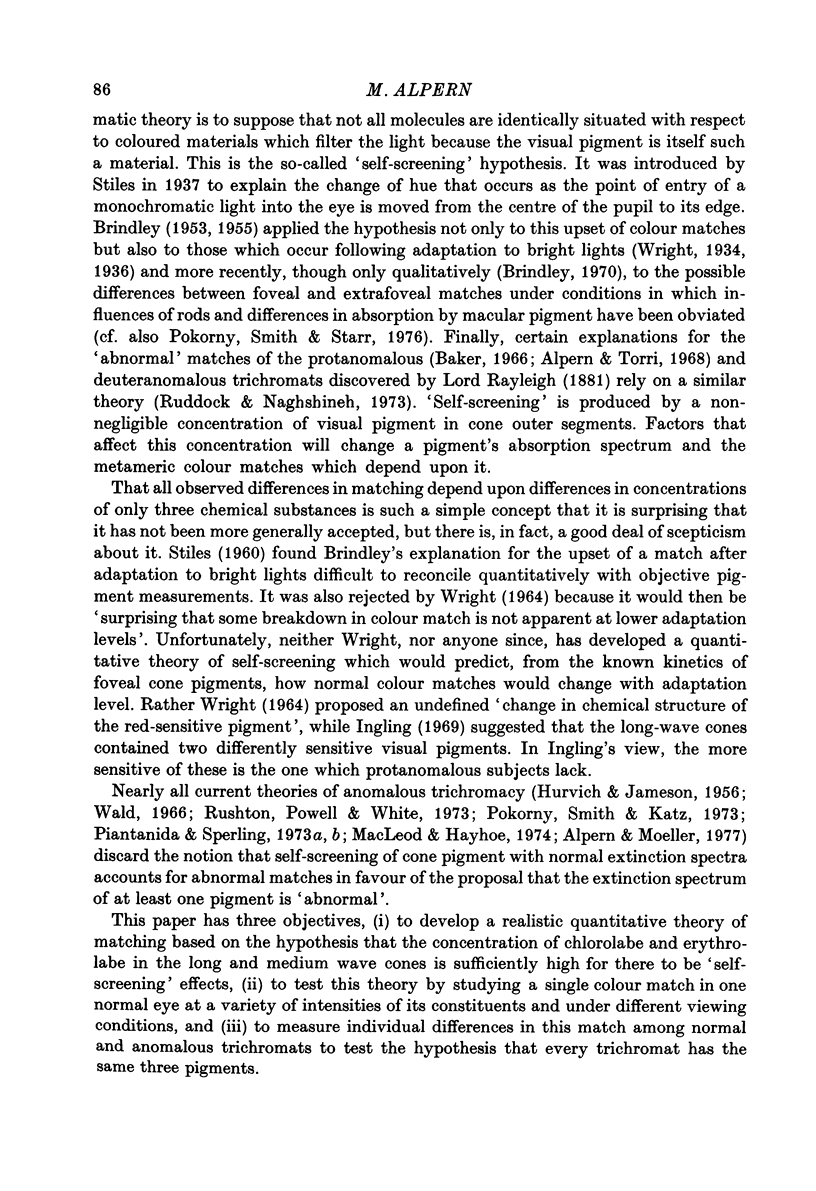
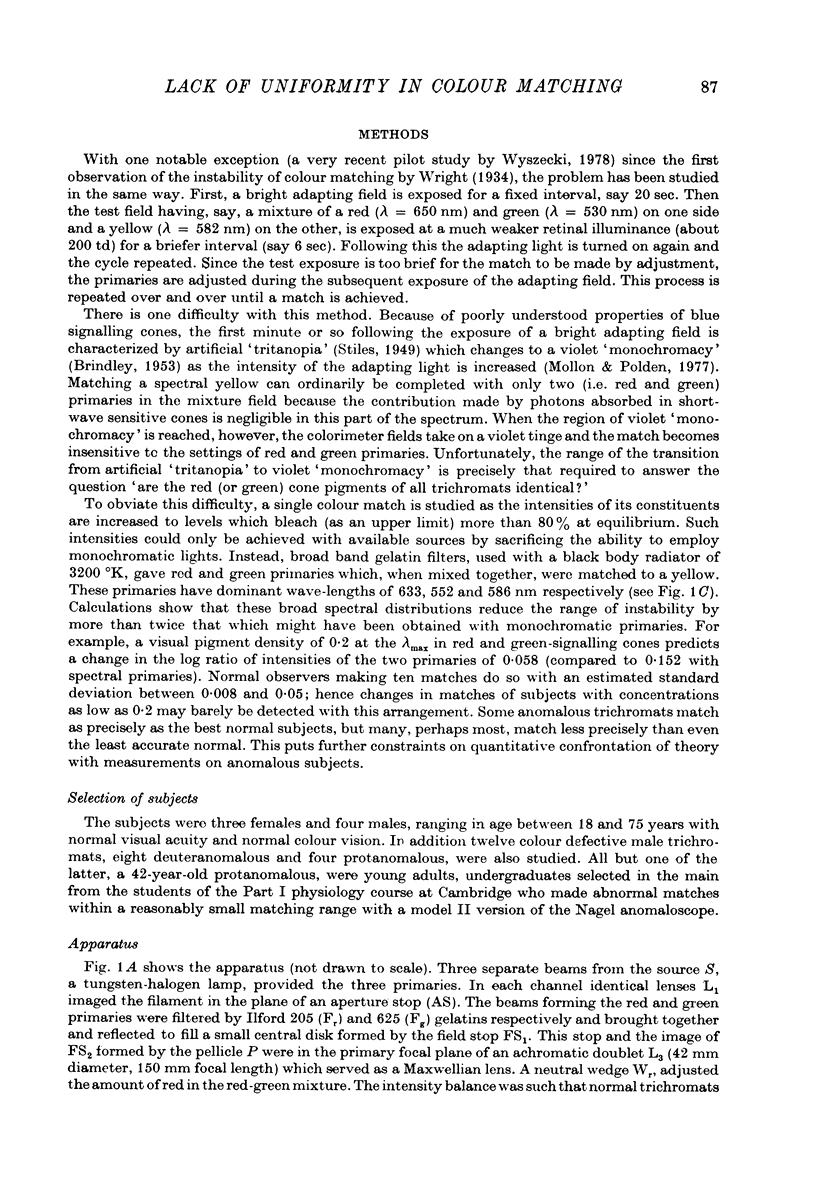
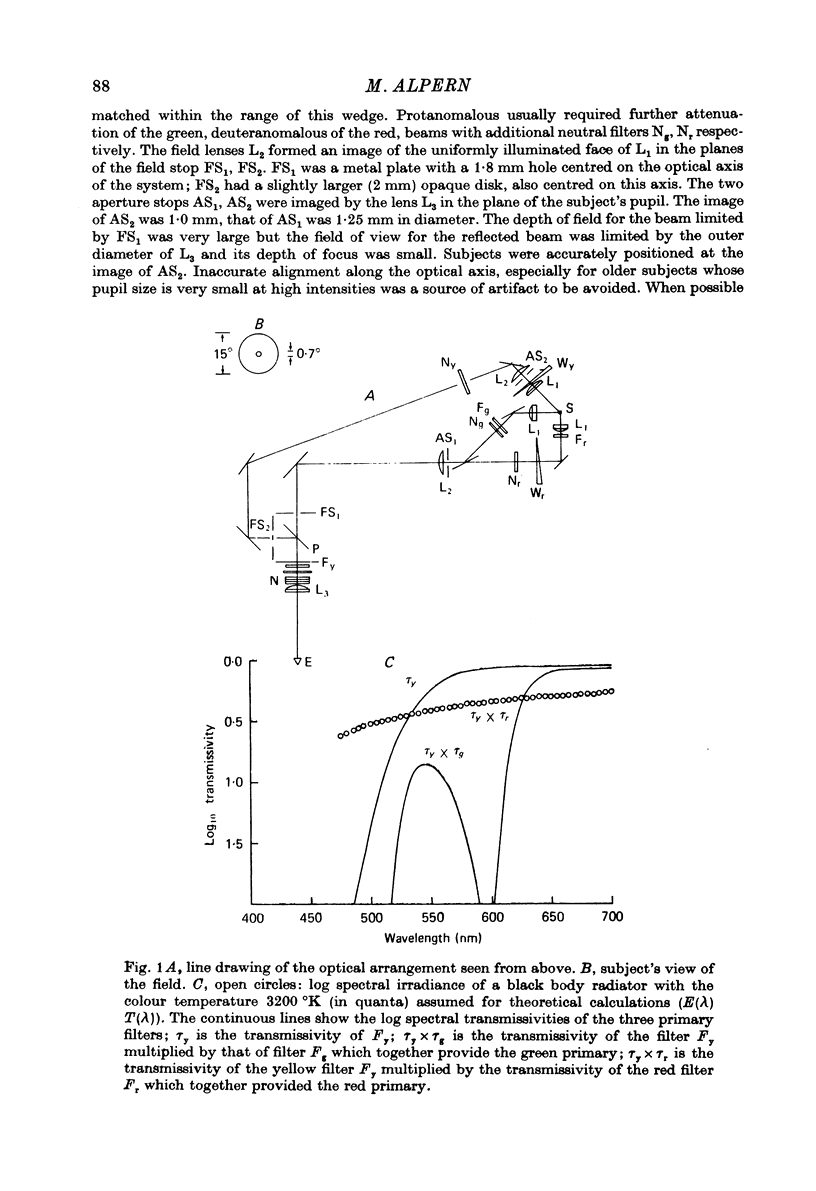
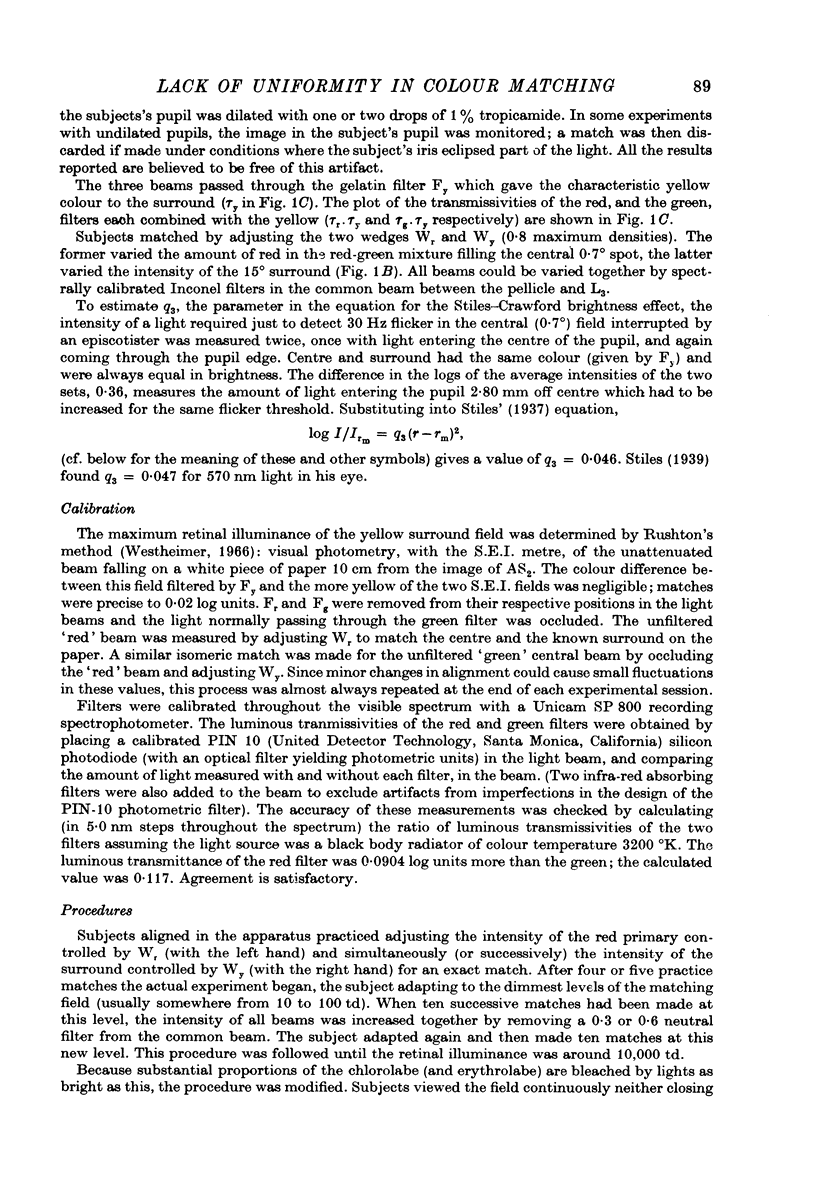
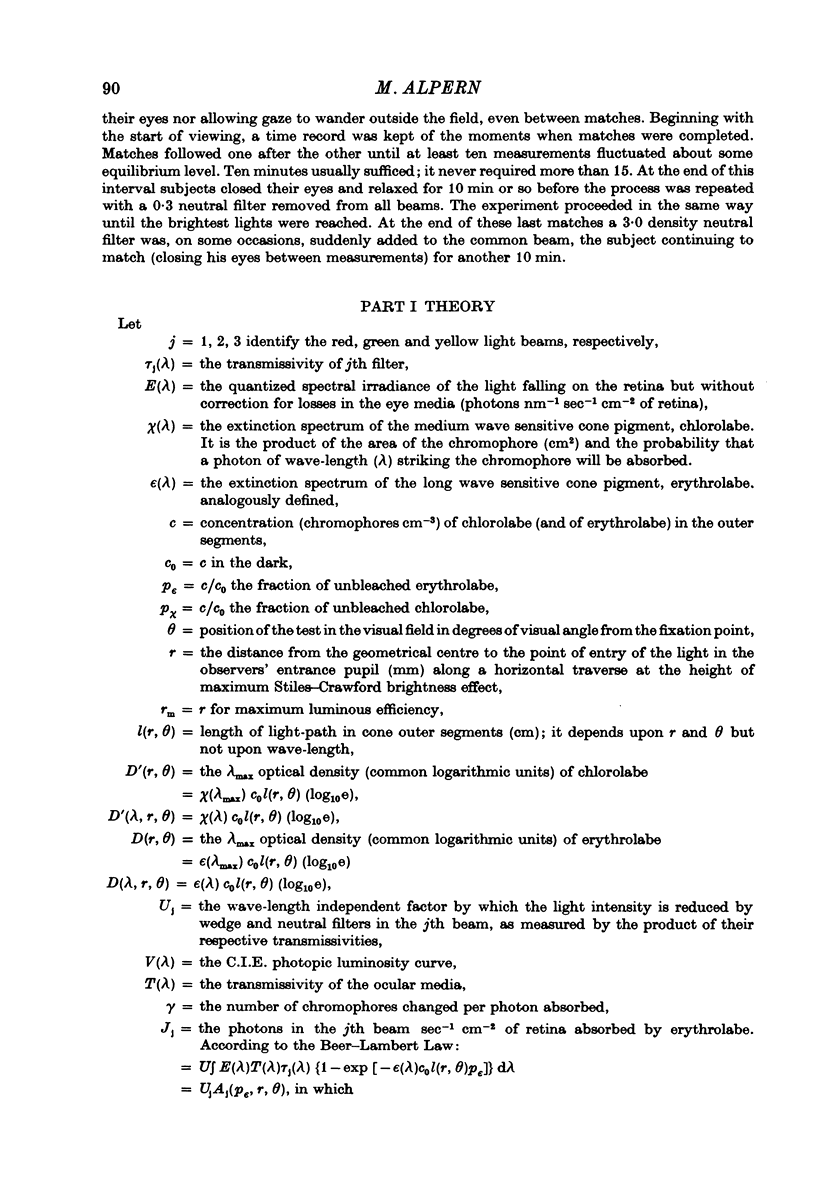
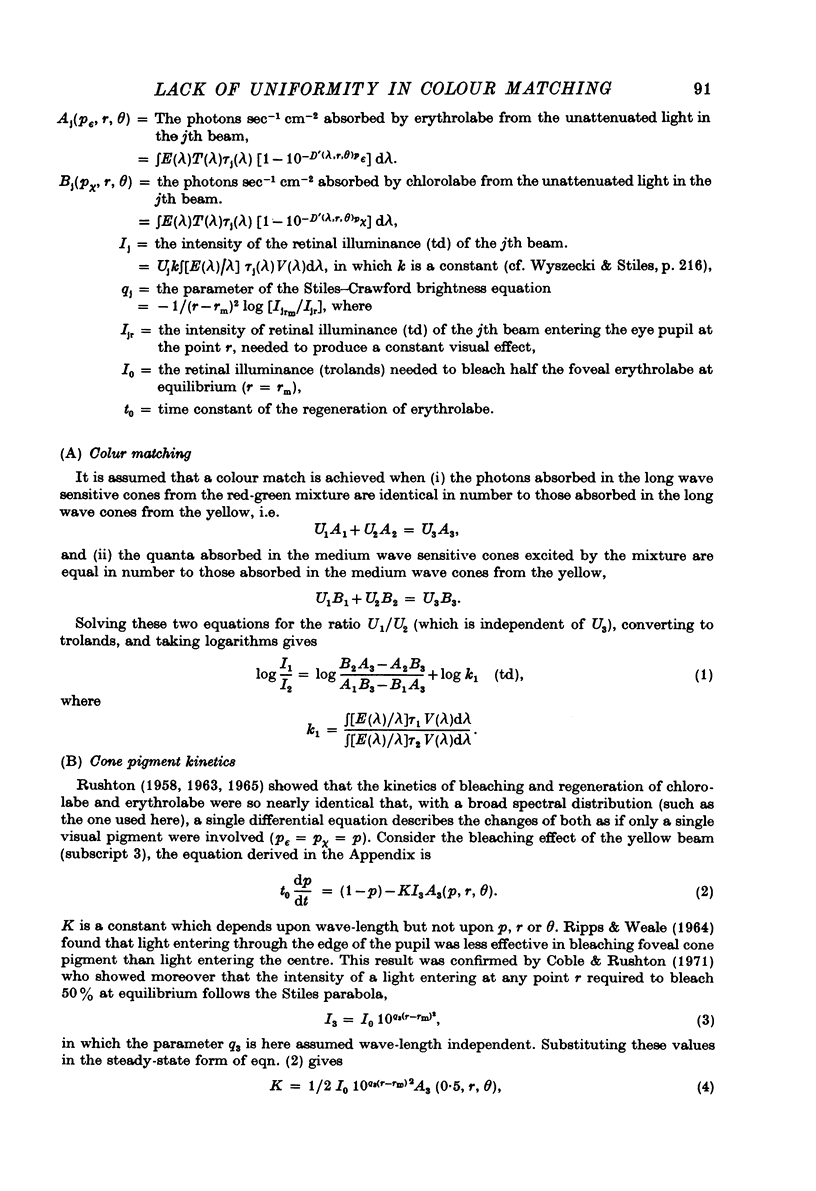

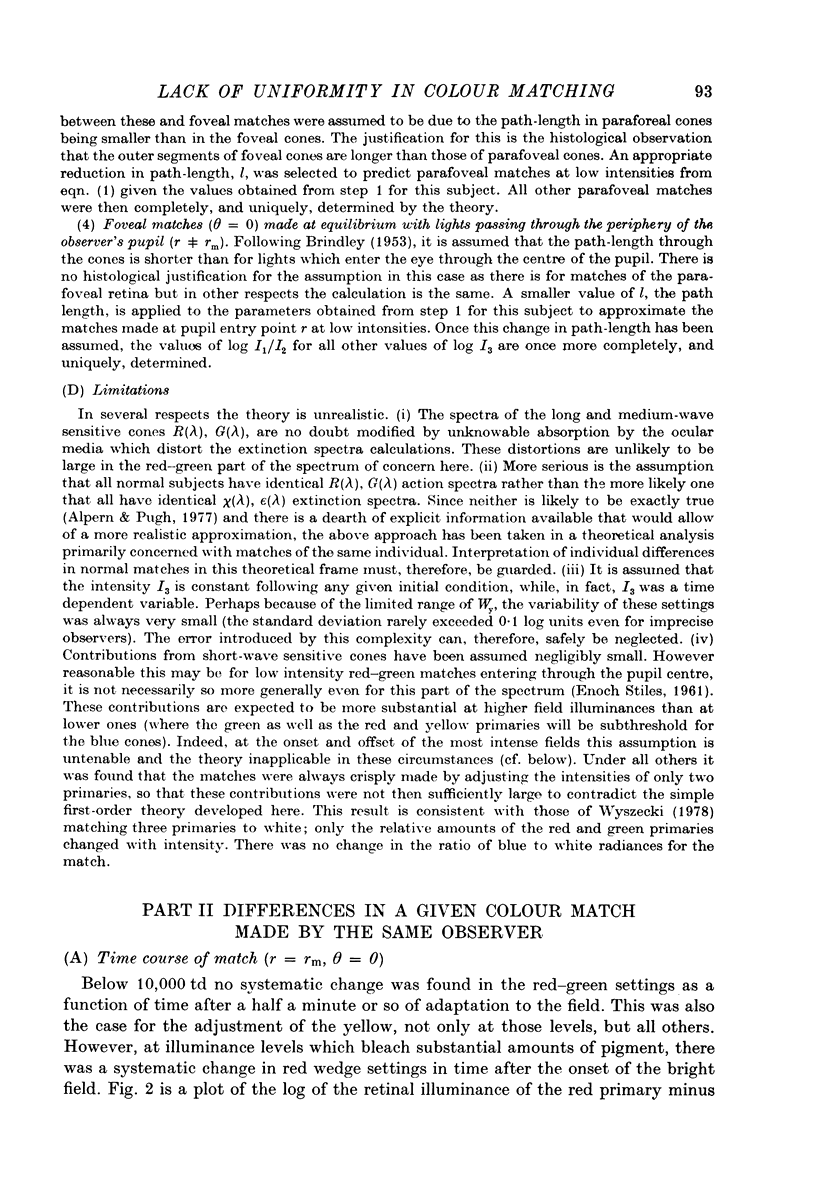
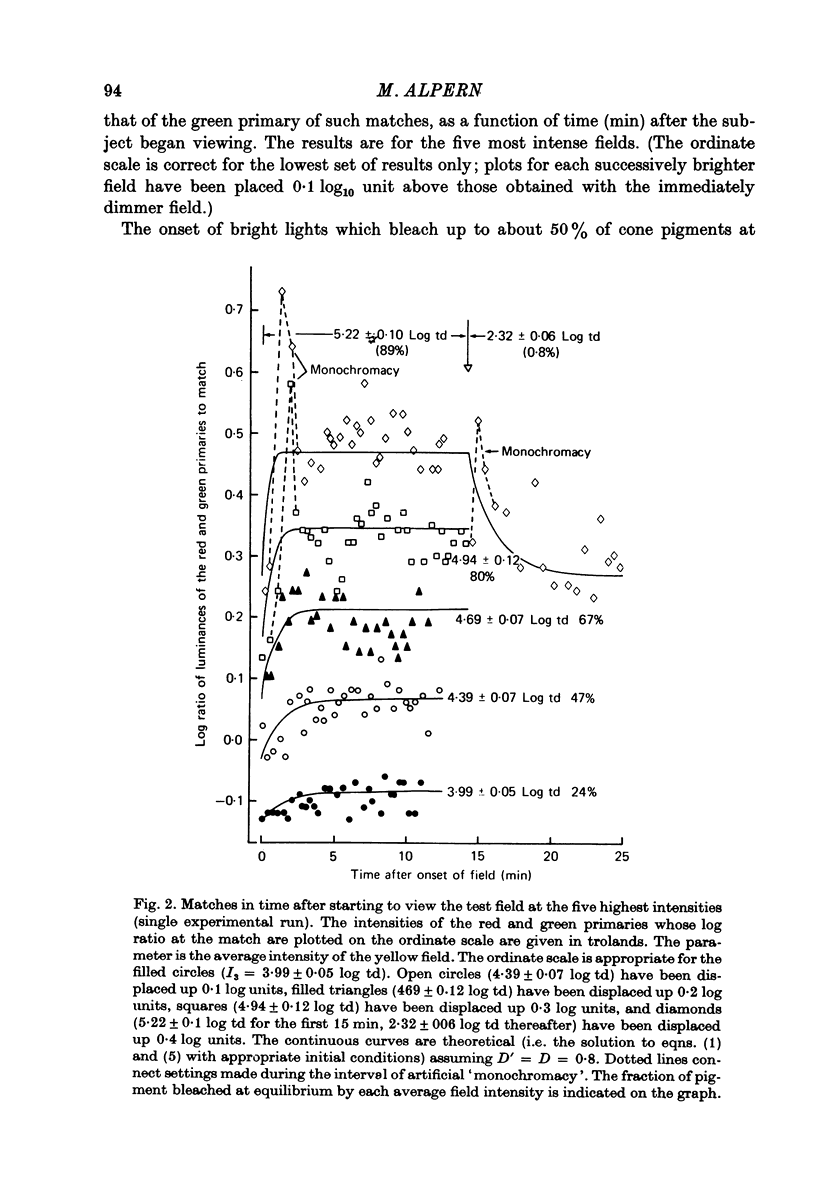
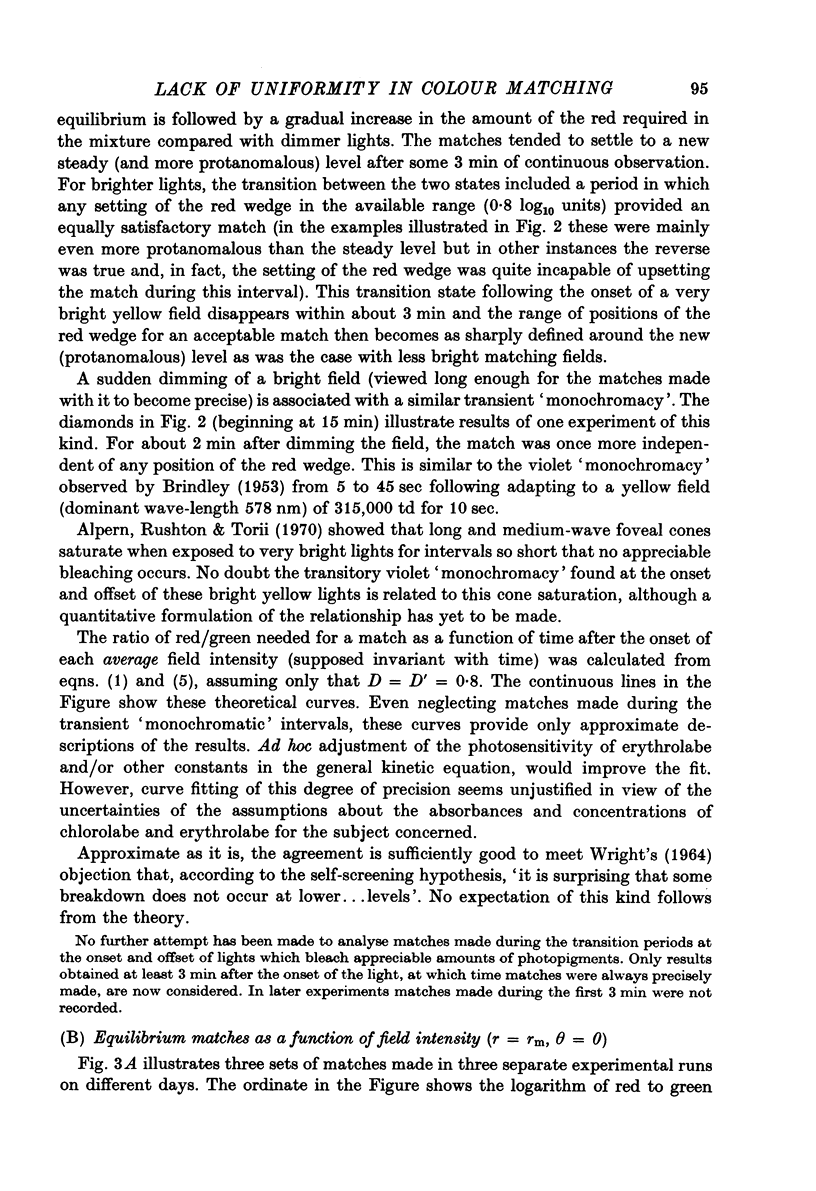

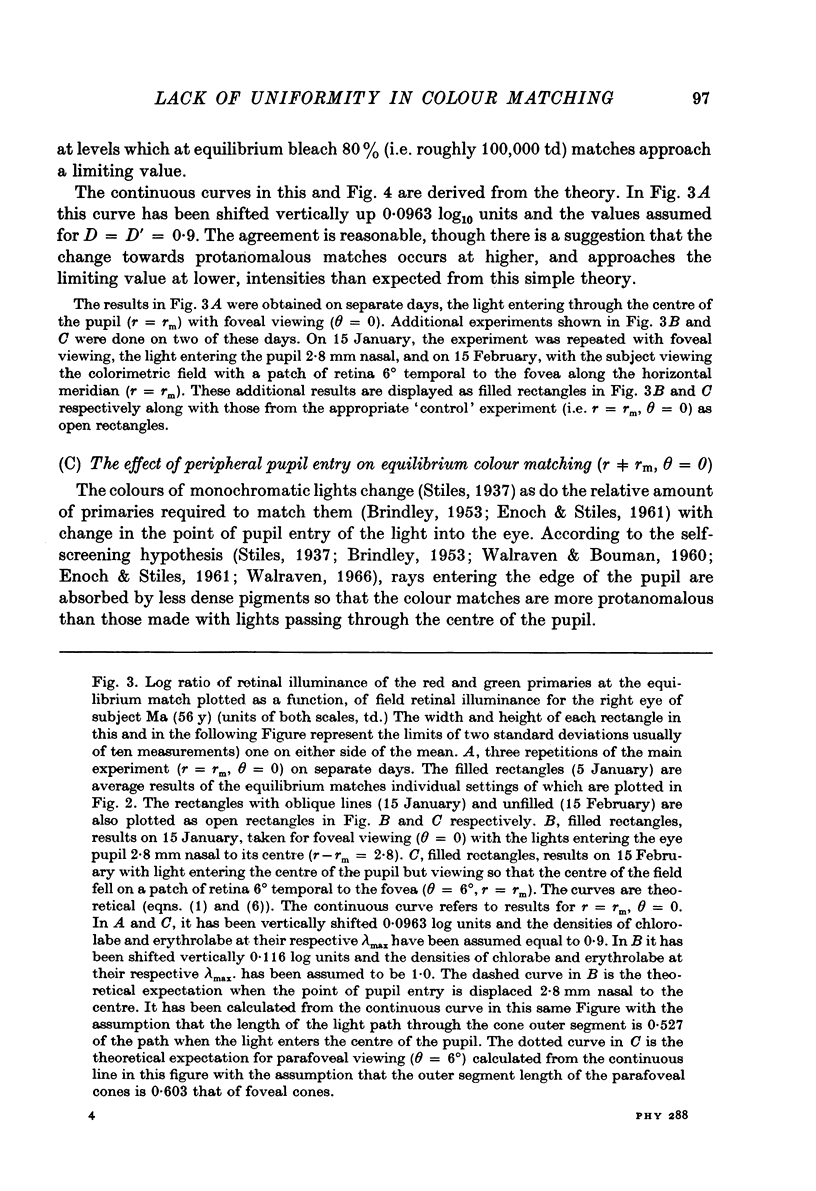
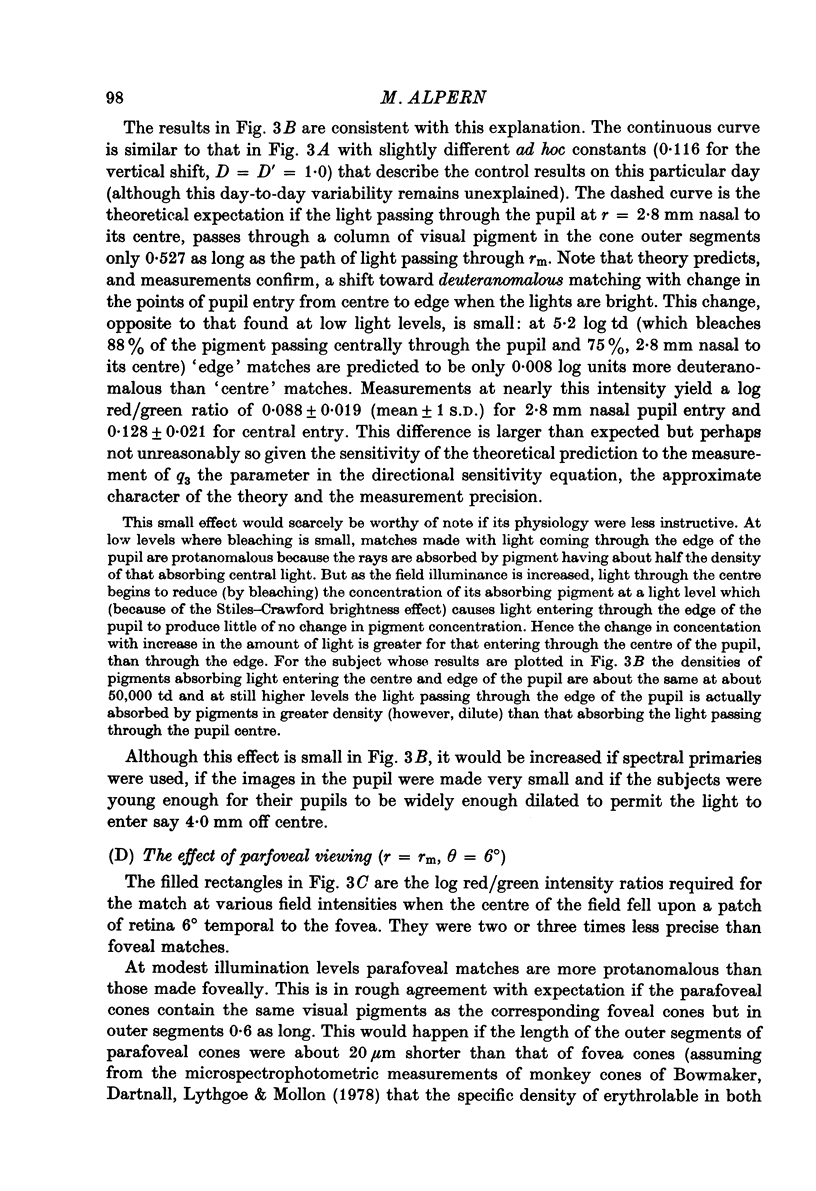
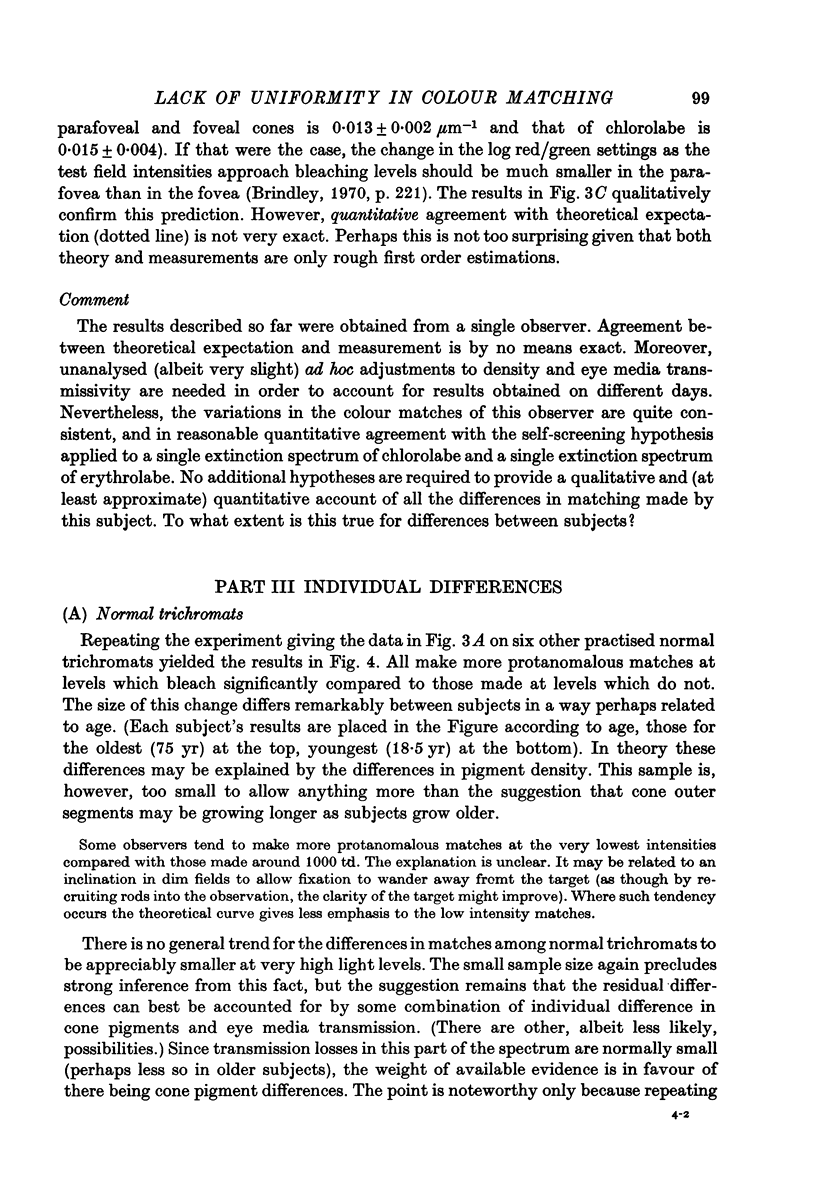
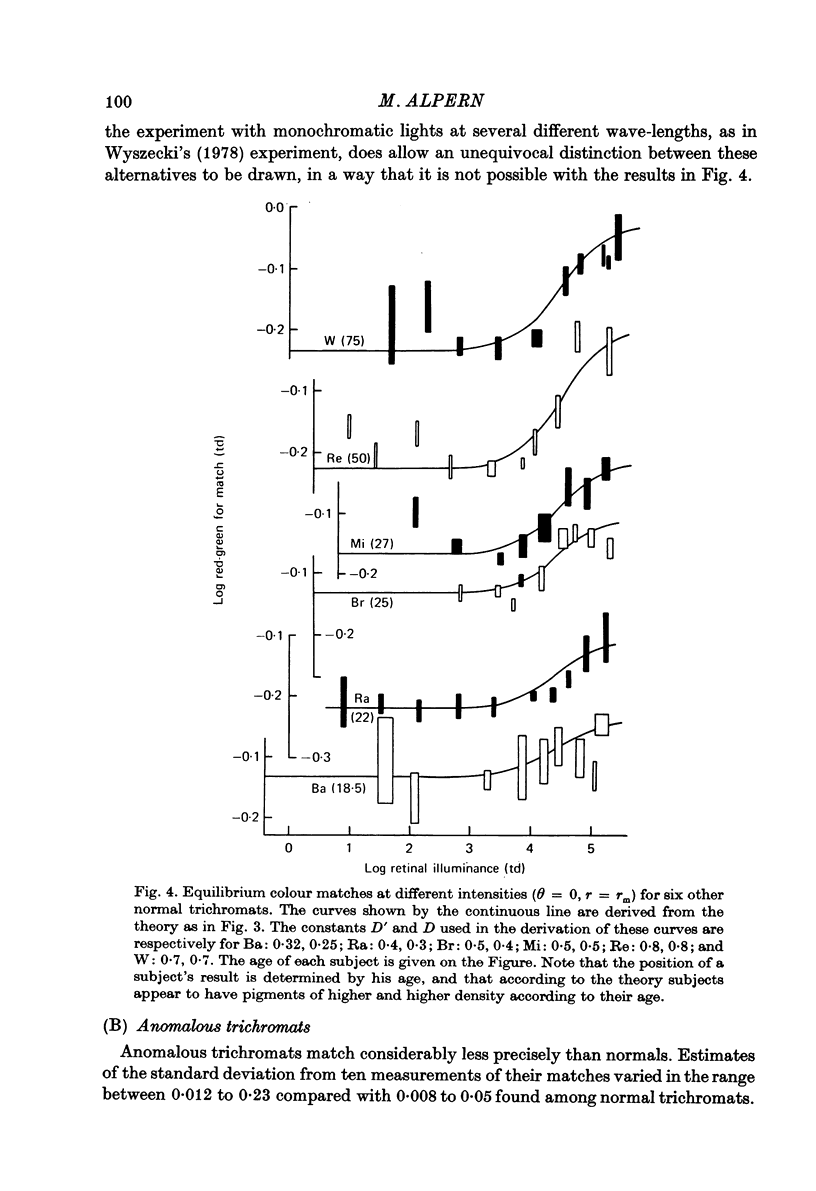
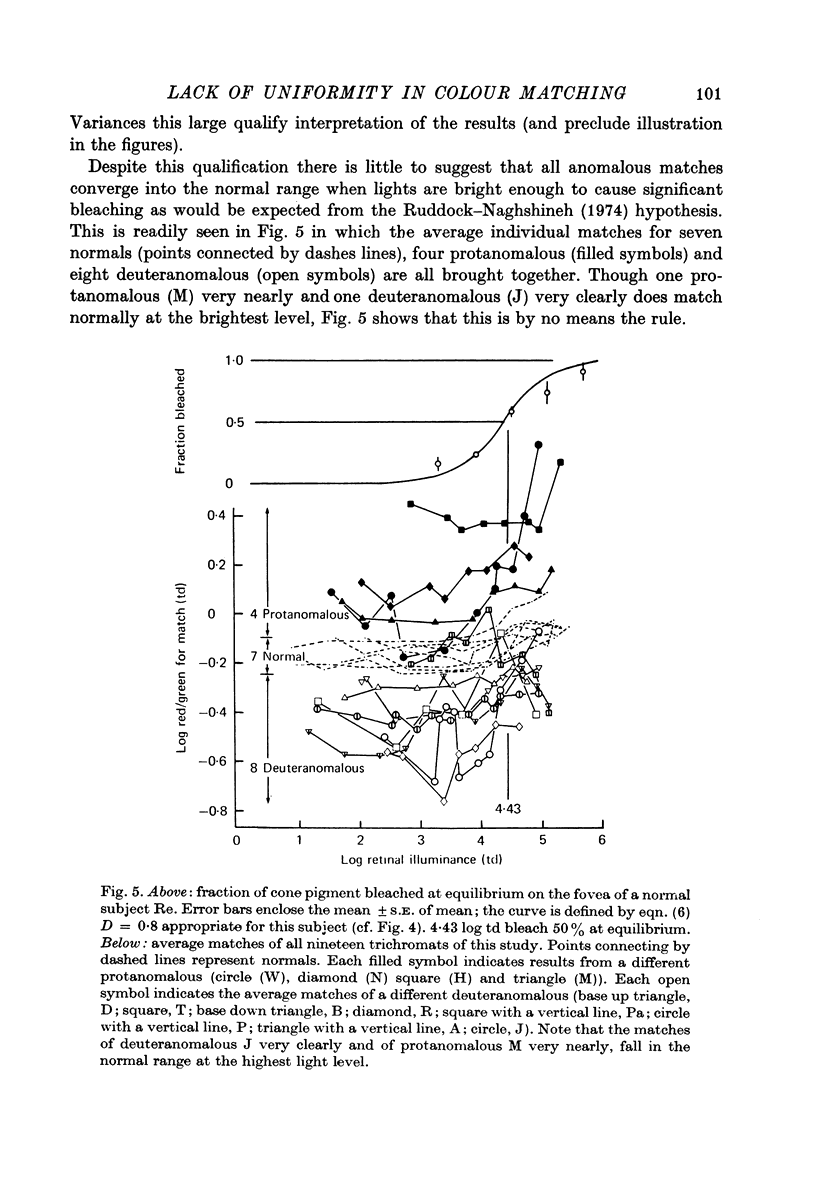

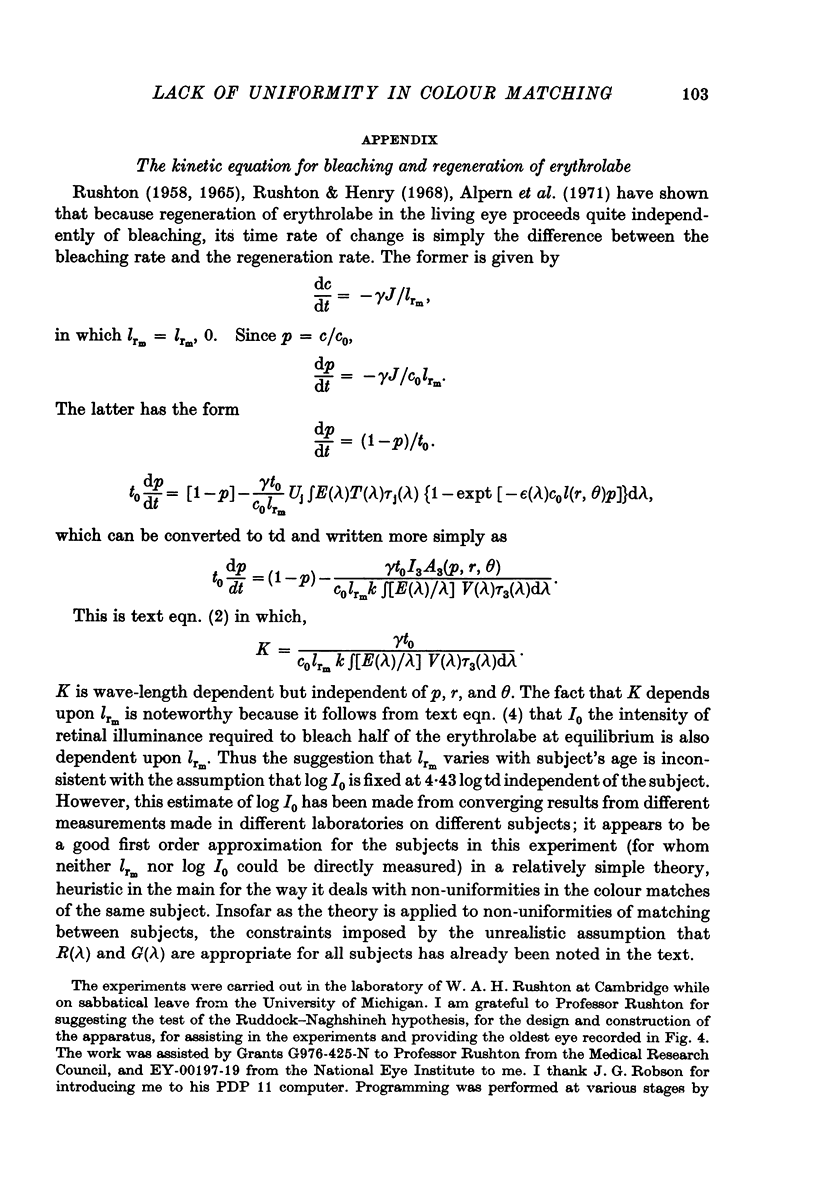
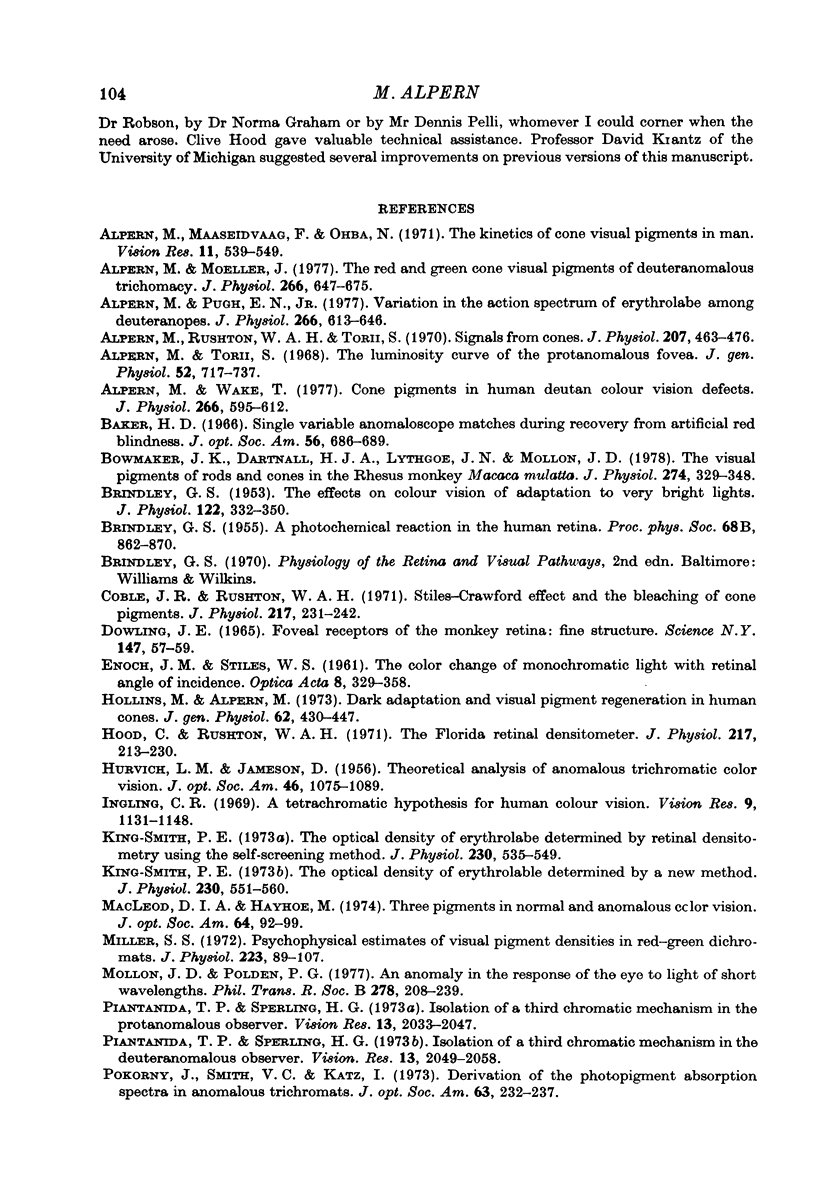
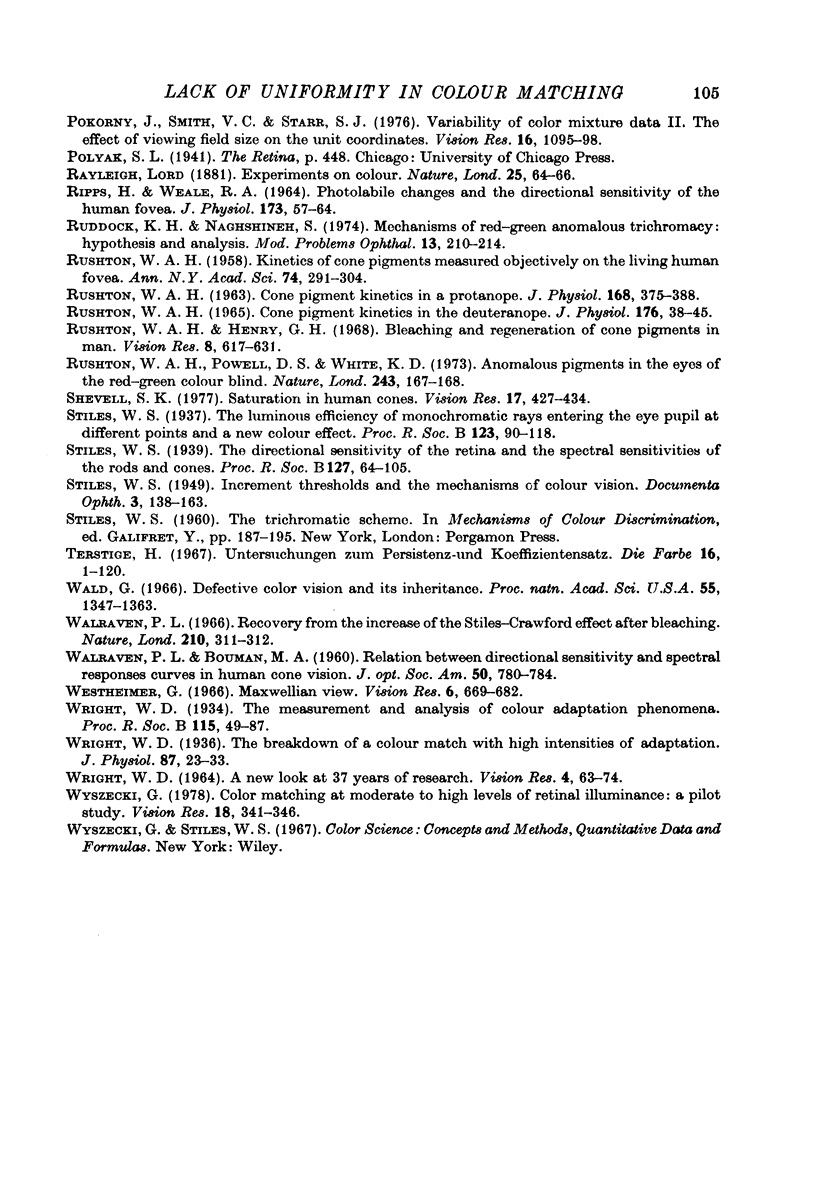
Selected References
These references are in PubMed. This may not be the complete list of references from this article.
- Alpern M., Maaseidvaag F., Oba N. The kinetics of cone visual pigments in man. Vision Res. 1971 Jun;11(6):539–549. doi: 10.1016/0042-6989(71)90075-7. [DOI] [PubMed] [Google Scholar]
- Alpern M., Moeller J. The red and green cone visual pigments of deuternomalous trichromacy. J Physiol. 1977 Apr;266(3):647–675. doi: 10.1113/jphysiol.1977.sp011786. [DOI] [PMC free article] [PubMed] [Google Scholar]
- Alpern M., Pugh E. N., Jr Variation in the action spectrum of erythrolabe among deuteranopes. J Physiol. 1977 Apr;266(3):613–646. doi: 10.1113/jphysiol.1977.sp011785. [DOI] [PMC free article] [PubMed] [Google Scholar]
- Alpern M., Rushton W. A., Torii S. Signals from cones. J Physiol. 1970 Apr;207(2):463–475. doi: 10.1113/jphysiol.1970.sp009073. [DOI] [PMC free article] [PubMed] [Google Scholar]
- Alpern M., Torii S. The luminosity curve of the protanomalous fovea. J Gen Physiol. 1968 Nov;52(5):717–737. doi: 10.1085/jgp.52.5.717. [DOI] [PMC free article] [PubMed] [Google Scholar]
- Alpern M., Wake T. Cone pigments in human deutan colour vision defects. J Physiol. 1977 Apr;266(3):595–612. doi: 10.1113/jphysiol.1977.sp011784. [DOI] [PMC free article] [PubMed] [Google Scholar]
- BRINDLEY G. S. The effects on colour vision of adaptation to very bright lights. J Physiol. 1953 Nov 28;122(2):332–350. doi: 10.1113/jphysiol.1953.sp005003. [DOI] [PMC free article] [PubMed] [Google Scholar]
- Baker H. D. Single-variable anomaloscope matches during recovery from artificial red blindness. J Opt Soc Am. 1966 May;56(5):686–689. doi: 10.1364/josa.56.000686. [DOI] [PubMed] [Google Scholar]
- Bowmaker J. K., Dartnall H. J., Lythgoe J. N., Mollon J. D. The visual pigments of rods and cones in the rhesus monkey, Macaca mulatta. J Physiol. 1978 Jan;274:329–348. doi: 10.1113/jphysiol.1978.sp012151. [DOI] [PMC free article] [PubMed] [Google Scholar]
- Coble J. R., Rushton W. A. Stiles-Crawford effect and the bleaching of cone pigments. J Physiol. 1971 Aug;217(1):231–242. doi: 10.1113/jphysiol.1971.sp009568. [DOI] [PMC free article] [PubMed] [Google Scholar]
- DOWLING J. E. FOVEAL RECEPTORS OF THE MONKEY RETINA: FINE STRUCTURE. Science. 1965 Jan 1;147(3653):57–59. doi: 10.1126/science.147.3653.57. [DOI] [PubMed] [Google Scholar]
- ENOCH J. M., STILES W. S. The colour change of monochromatic light with retinal angle of incidence. Optom Wkly. 1961 Oct;8(52):329–358. doi: 10.1080/713826396. [DOI] [PubMed] [Google Scholar]
- HURVICH L. M., JAMESON D. Theoretical analysis of anomalous trichromatic color vision. J Opt Soc Am. 1956 Dec;46(12):1075–1089. doi: 10.1364/josa.46.001075. [DOI] [PubMed] [Google Scholar]
- Hollins M., Alpern M. Dark adaptation and visual pigment regeneration in human cones. J Gen Physiol. 1973 Oct;62(4):430–447. doi: 10.1085/jgp.62.4.430. [DOI] [PMC free article] [PubMed] [Google Scholar]
- Hood C., Rushton W. A. The Florida retinal densitometer. J Physiol. 1971 Aug;217(1):213–229. doi: 10.1113/jphysiol.1971.sp009567. [DOI] [PMC free article] [PubMed] [Google Scholar]
- Ingling C. R., Jr A tetrachromatic hypothesis for human color vision. Vision Res. 1969 Sep;9(9):1131–1148. doi: 10.1016/0042-6989(69)90052-2. [DOI] [PubMed] [Google Scholar]
- King-Smith P. E. The optical density of erythrolabe determined by a new method. J Physiol. 1973 May;230(3):551–560. doi: 10.1113/jphysiol.1973.sp010203. [DOI] [PMC free article] [PubMed] [Google Scholar]
- King-Smith P. E. The optical density of erythrolabe determined by retinal densitometry using the self-screening method. J Physiol. 1973 May;230(3):535–549. doi: 10.1113/jphysiol.1973.sp010202. [DOI] [PMC free article] [PubMed] [Google Scholar]
- MacLeod D. I., Hayhoe M. Three pigments in normal and anomalous color vision. J Opt Soc Am. 1974 Jan;64(1):92–96. doi: 10.1364/josa.64.000092. [DOI] [PubMed] [Google Scholar]
- Miller S. S. Psychophysical estimates of visual pigment densities in red-green dichromats. J Physiol. 1972 May;223(1):89–107. doi: 10.1113/jphysiol.1972.sp009836. [DOI] [PMC free article] [PubMed] [Google Scholar]
- Piantanida T. P., Sperling H. G. Isolation of a third chromatic mechanism in the deuteranomalous observer. Vision Res. 1973 Nov;13(11):2049–2058. doi: 10.1016/0042-6989(73)90181-8. [DOI] [PubMed] [Google Scholar]
- Piantanida T. P., Sperling H. G. Isolation of a third chromatic mechanism in the protanomalous observer. Vision Res. 1973 Nov;13(11):2033–2047. doi: 10.1016/0042-6989(73)90180-6. [DOI] [PubMed] [Google Scholar]
- Pokorny J., Smith V. C., Katz I. Derivation of the photopigment absorption spectra in anomalous trichromats. J Opt Soc Am. 1973 Feb;63(2):232–237. doi: 10.1364/josa.63.000232. [DOI] [PubMed] [Google Scholar]
- Pokorny J., Smith V. C., Starr S. J. Variability of color mixture data - II. The effect of viewing field size on the unit coordinates. Vision Res. 1976;16(10):1095–1098. doi: 10.1016/0042-6989(76)90248-0. [DOI] [PubMed] [Google Scholar]
- RIPPS H., WEALE R. A. PHOTO-LABILE CHANGES AND THE DIRECTIONAL SENSITIVITY OF THE HUMAN FOVEA. J Physiol. 1964 Sep;173:57–64. doi: 10.1113/jphysiol.1964.sp007442. [DOI] [PMC free article] [PubMed] [Google Scholar]
- RUSHTON W. A. CONE PIGMENT KINETICS IN THE DEUTERANOPE. J Physiol. 1965 Jan;176:38–45. doi: 10.1113/jphysiol.1965.sp007533. [DOI] [PMC free article] [PubMed] [Google Scholar]
- RUSHTON W. A. CONE PIGMENT KINETICS IN THE PROTANOPE. J Physiol. 1963 Sep;168:374–388. doi: 10.1113/jphysiol.1963.sp007198. [DOI] [PMC free article] [PubMed] [Google Scholar]
- RUSHTON W. A. Kinetics of cone pigments measured objectively on the living human fovea. Ann N Y Acad Sci. 1959 Nov 12;74(2):291–304. doi: 10.1111/j.1749-6632.1958.tb39552.x. [DOI] [PubMed] [Google Scholar]
- Ruddock K. H., Naghshineh S. Mechanisms of red-green anomalous trichromacy: hypothesis and analysis. Mod Probl Ophthalmol. 1974;13(0):210–214. [PubMed] [Google Scholar]
- Rushton W. A., Henry G. H. Bleaching and regeneration of cone pigments in man. Vision Res. 1968 Jun;8(6):617–631. doi: 10.1016/0042-6989(68)90040-0. [DOI] [PubMed] [Google Scholar]
- Rushton W. A., Powell D. S., White K. D. Anomalous pigments in the eyes of the red-green colour blind. Nature. 1973 May 18;243(5403):167–168. doi: 10.1038/243167a0. [DOI] [PubMed] [Google Scholar]
- STILES W. S. Increment thresholds and the mechanisms of colour vision. Doc Ophthalmol. 1949;3:138–165. doi: 10.1007/BF00162601. [DOI] [PubMed] [Google Scholar]
- Shevell S. K. Saturation in human cones. Vision Res. 1977;17(3):427–434. doi: 10.1016/0042-6989(77)90035-9. [DOI] [PubMed] [Google Scholar]
- WALRAVEN P. L., BOUMAN M. A. Relation between directional sensitivity and spectral response curves in human cone vision. J Opt Soc Am. 1960 Aug;50:780–784. doi: 10.1364/josa.50.000780. [DOI] [PubMed] [Google Scholar]
- Wald G. Defective color vision and its inheritance. Proc Natl Acad Sci U S A. 1966 Jun;55(6):1347–1363. doi: 10.1073/pnas.55.6.1347. [DOI] [PMC free article] [PubMed] [Google Scholar]
- Walraven P. L. Recovery from the increase of the Stiles-Crawford effect after bleaching. Nature. 1966 Apr 16;210(5033):311–312. doi: 10.1038/210311a0. [DOI] [PubMed] [Google Scholar]
- Westheimer G. The Maxwellian view. Vision Res. 1966 Dec;6(12):669–682. doi: 10.1016/0042-6989(66)90078-2. [DOI] [PubMed] [Google Scholar]
- Wright W. D. A new look at 37 years of research. Vision Res. 1964 May;4(1):63–74. doi: 10.1016/0042-6989(64)90033-1. [DOI] [PubMed] [Google Scholar]
- Wright W. D. The breakdown of a colour match with high intensities of adaptation. J Physiol. 1936 Jun 10;87(1):23–33. doi: 10.1113/jphysiol.1936.sp003385. [DOI] [PMC free article] [PubMed] [Google Scholar]
- Wyszecki G. Color matching at moderate to high levels of retinal illuminance: a pilot study. Vision Res. 1978;18(3):341–346. doi: 10.1016/0042-6989(78)90170-0. [DOI] [PubMed] [Google Scholar]


